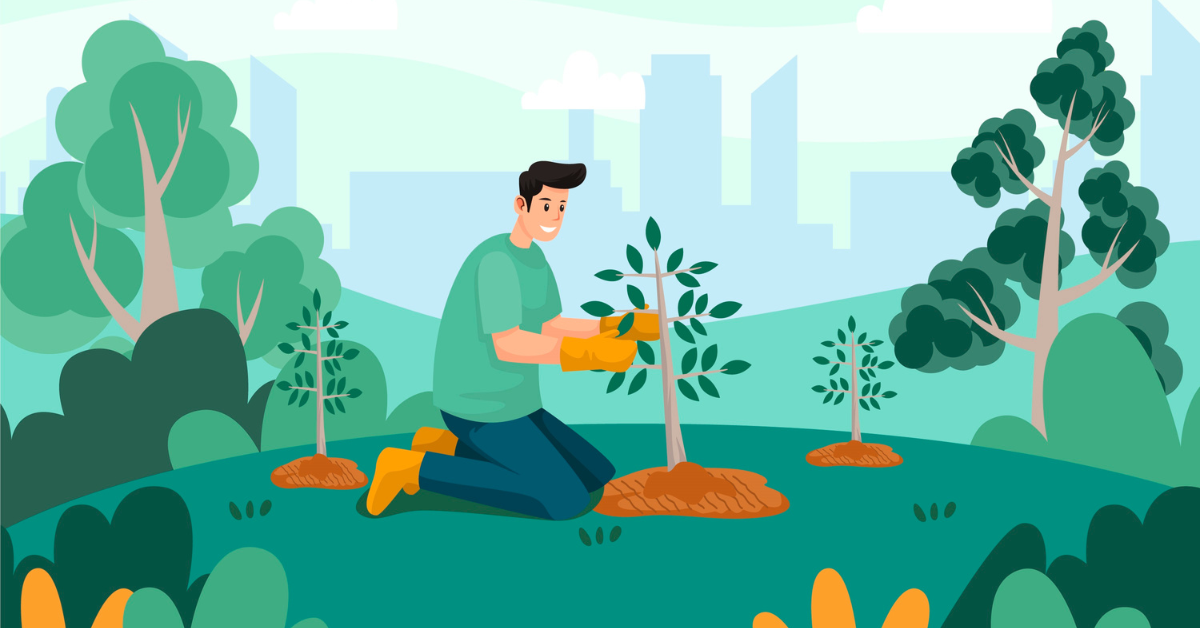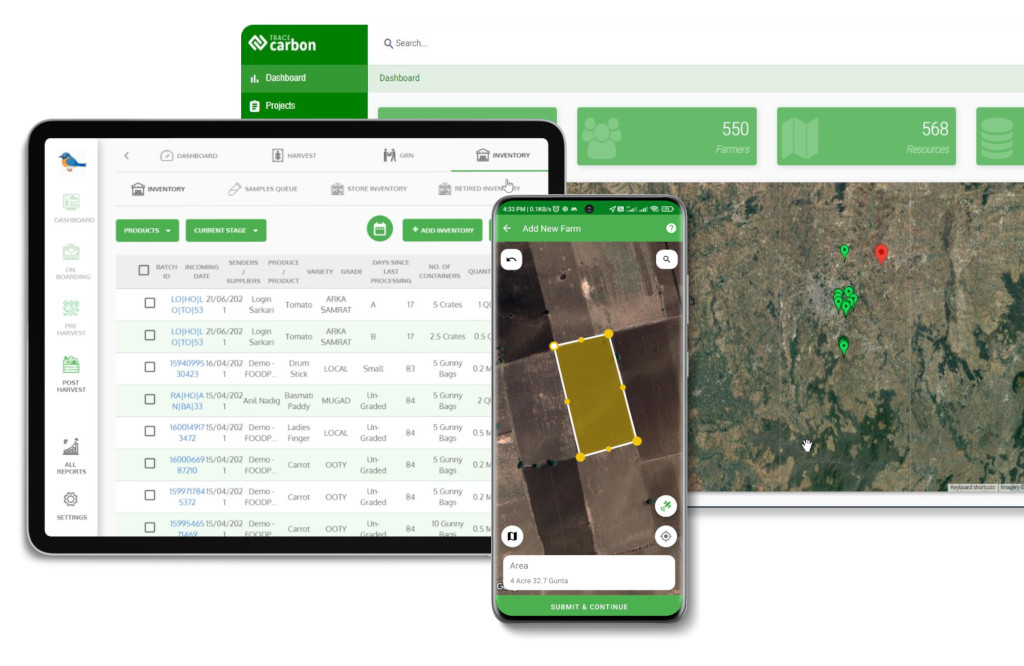Contact: +91 99725 24322 |
Menu
Menu
Quick summary: Discover how agroforestry empowers modern farmers to boost yields, enhance biodiversity, meet EUDR compliance, and unlock new revenue streams through traceable, sustainable practices.

Agroforestry for sustainable agriculture integrates trees with crops and livestock on the same land to build resilient, productive farms. Recognized by the FAO as a key climate smart practice, it improves soil fertility, conserves water, enhances biodiversity, and creates additional income streams through timber, fodder, and fruits. Studies show agroforestry can boost yields by 20–30% while restoring degraded land and reducing emissions. For modern farmers, it offers a proven path to meet sustainability goals, strengthen compliance with emerging regulations and unlock premium markets by demonstrating deforestation free, traceable production systems.
According to ICFRE, our nation occupies just 2.4% of the global land area and 0.5% of the grazing space, yet it sustains over 16% of the world’s population and 18% of its cattle. This rapidly increasing population exerts significant demands on our land and forest resources. Agroforestry offers a promising alternative to enhance tree cover beyond designated forest zones, thereby alleviating the burden on forested land. Furthermore, agroforestry represents the sole feasible strategy for attaining the goal of 33% tree or green cover.
Today’s farmers face shrinking margins, erratic weather, and rising pressure from buyers to prove sustainability and deforestation free practices. Traditional monocropping struggles to meet these demands, leaving many farmers vulnerable to soil degradation, compliance hurdles, and lost market opportunities.
Enter agroforestry: an integrated approach that combines trees, crops, and livestock—offering resilience, higher yields, and a clear path toward sustainable agriculture.
Key Takeaways
According to the Food and Agriculture Organization (FAO), agroforestry is the deliberate integration of trees with crops and/or livestock on the same land management system to deliver economic, environmental, and social benefits. Unlike conventional monocropping, it creates a multifunctional landscape where each component—trees, crops, and animals—supports the others.
Agroforestry is not just a farming technique; it’s a systems-level redesign of how we use land.
Agroforestry turns farms into regenerative ecosystems, helping farmers shift from extractive practices to land stewardship—an approach increasingly rewarded by conscious buyers and regulators.
While many see agroforestry as an old practice, its modern application is highly tech enabled—geospatial mapping, IoT soil sensors, and compliance dashboards now make it measurable and auditable. For forward-thinking farmers, agroforestry isn’t just sustainable farming; it’s a market access strategy and a bridge between tradition and NextGen AgriTech.
Explore our latest blogs on
Climatesmart farming practices
packed with insights, best practices, and tools to help you grow smarter and stay compliant in evolving markets.
Many farmers lack access to agronomic expertise on how to select tree species, design plot layouts, or balance shading with crop needs. Poorly planned agroforestry can reduce yields instead of improving them.
Platforms with Geo mapping and advisory modules provide tailored recommendations based on soil data, climate zones, and local regulations—so farmers get design blueprints, not guesswork.
Establishing tree systems involves initial investments in seedlings, irrigation, and labor, which can be a barrier—especially for smallholders.
Traceability platforms create a verifiable digital record of sustainable practices. Farmers can use these records to access green finance, carbon credit programs, or buyer prefinancing because they can prove compliance and future value.
Agroforestry often demands new reporting—tracking plot locations, input usage, and sustainability metrics to meet buyer or regulatory requirements. Many farmers struggle with paper based systems.
Mobile apps and dashboards simplify data capture at the field level. Geotagging plots, uploading images of seedlings, and storing input receipts are all automated—generating audit ready reports without extensive paperwork.
By addressing these barriers with technology:
Agroforestry doesn’t just grow crops—it rebuilds the foundation they rely on. Tree roots penetrate deeper soil layers, drawing up nutrients that annual crops can’t access. Fallen leaves decompose into organic matter, naturally enriching the soil and reducing the need for synthetic fertilizers.
In a world where input costs are rising, agroforestry turns the farm itself into a living fertilizer factory.
Trees act as carbon sinks, locking away CO₂ while also shielding crops from temperature spikes, high winds, and erratic rainfall. By creating microclimates, agroforestry systems protect yields during extreme weather events that are becoming more frequent.
Farmers adopting agroforestry aren’t just feeding their communities—they’re quietly running some of the most efficient carbon capture projects on earth.
Integrating trees attracts pollinators like bees and butterflies, and birds that feed on pests. This natural ecosystem management reduces dependence on chemical pesticides while improving crop set and quality.
Rather than fighting nature with sprays, agroforestry farmers partner with it, inviting biodiversity back into their fields as an unpaid workforce.
Agroforestry diversifies income beyond a single harvest. Timber, nuts, fruits, and animal fodder provide seasonal cash flows and buffer against commodity price volatility.
For smallholders, every tree becomes a micro savings account, offering both long-term security and market leverage when prices fluctuate.
Approximately 1.2 billion people depend directly on agroforestry products and services in rural and urban areas of developing countries.
Agroforestry isn’t just about sustainability—it’s about building resilient, profitable farms that align with global compliance standards like and tap into premium, sustainabilityminded markets.
Under the EU Deforestation Regulation (EUDR), any product entering the EU market must be proven deforestationfree and legally sourced. Agroforestry systems, by design, integrate trees into farmland rather than clearing them—making it easier to demonstrate compliance with these strict environmental standards.

In India, average carbon sequestration potential in agroforestry has been estimated to be 25 t/ha over 96 million ha but it varied substantially by regions depending upon the production of biomass
Agroforestry is increasingly recognized as a powerful pathway to generate carbon credits, because trees integrated into farmland act as natural carbon sinks. As they grow, trees capture and store atmospheric CO₂ in biomass and soil, creating measurable emissions reductions that can be certified and monetized in voluntary or compliance carbon markets. For farmers and cooperatives, this means agroforestry is not just about better yields and resilience—it’s also a potential revenue stream. By using digital monitoring and traceability platforms like TraceX, projects can geotag plots, track survival rates, and generate verifiable data required by carbon registries, turning sustainable land management into tradable carbon assets that attract buyers and investors.
The agroforestry framework covers baselining land and farmer data, distributing and planting saplings, monitoring growth, verifying practices, reporting results, and measuring impact. TraceX streamlines each step with geotagged mapping, mobile data capture, AI driven monitoring, and audit ready reporting. This ensures projects can prove deforestation free practices, unlock carbon credits, and meet standards all through one integrated digital platform.
What happens
A baseline survey maps current land use, soil conditions, farmer profiles, and existing vegetation before the project starts.
How TraceX helps
What happens:
Seedlings are sourced and distributed to farmers or cooperatives.
How TraceX helps:
What happens:
Farmers plant trees in alignment with agroforestry designs (alley cropping, windbreaks, etc.).
How TraceX helps:
What happens:
Tree survival rates, growth, and intercropped yields are regularly monitored.
How TraceX helps:
What happens:
Third-party auditors or project managers verify that claims match on-ground reality.
How TraceX helps:
What happens:
Compiled data is reported to buyers, regulators, or funding agencies.
How TraceX helps:
What happens:
Demonstrating outcomes—carbon sequestration, increased yields, farmer incomes—to unlock premiums or funding.
How TraceX helps:
Agroforestry is more than a farming method—it’s a strategy for resilience, compliance, and long-term prosperity. By integrating trees with crops and livestock, modern farmers can improve soil health, build climate resilient systems, and meet global sustainability standards. With digital tools such as TraceX, these practices are no longer difficult to manage or verify; they become measurable assets that open access to premium markets and carbon finance. The future of farming is regenerative, data driven, and ready for growth.
Dive into our expert blogs on
Agroforestry in commodity supply chains
learn how these strategies transform compliance, unlock new markets, and drive measurable impact.
Agroforestry is the integration of trees, crops, and sometimes livestock on the same land to improve soil fertility, biodiversity, and farm resilience while maintaining deforestation free practices.
Agroforestry systems are inherently deforestation free and can be geotagged and digitally tracked, making it easier to generate audit ready data for EUDR and similar regulations.
TraceX provides digital monitoring, reporting, and verification tools that capture field data, track saplings, and generate compliance ready reports—simplifying adoption and unlocking market opportunities.
